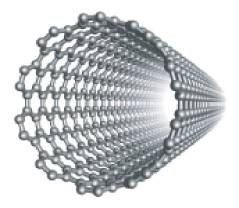
Nanotubes are a very popular aspect of nanotechnology because of the interesting features that they possess. SWNTs have strengths determined to be 50-100 times that of steel and with an elasticity on the order of terrapascals, which is among the most elastic materials on Earth. Moreover, nanotubes have a higher thermal conductivity than any natural material and 100 times the electrical conductivity of copper, the most commonly used conductor in electronics. Nanotubes have a density half that of aluminum and, to top it off, are stable of temperatures exceeding 2700 degrees C.
Applications
One of the mort commonly sited applications of carbon nanotubes is for use in electronics as nano-sized transistors. Their size and manipulatability in the nano levels are promising as we attempt to keep up with Moore's law to create smaller and smaller chips. Moreover, the potential of nanotubes for superconductivity drastically reduces the heat waste in transmission that creates such a problem in today's computers. Though the technology is still in its relative infancy, nanotubes look to be the next revolution in chip-making that will allow us to keep up with the breathtaking progression that Moore's law predicts.
Their amazing mechanical properties give nanotubes many other potential applications as well. For instance, nanotubes are being used in bikes in the Tour de France and being researched as materials for use in space by NASA. As production of carbon nanotubes becomes cheaper and more precise, their applications will surely multiply.

No comments:
Post a Comment